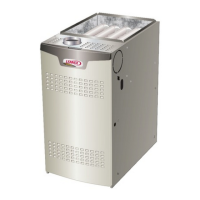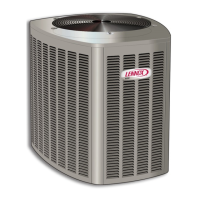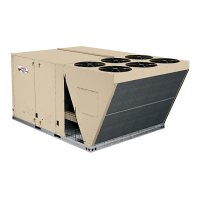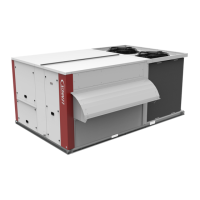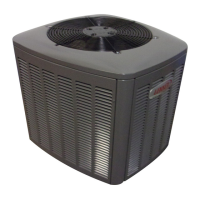Page 42
Applications Using A Single-Stage Thermostat
See Figure 28 for ignition control sequence
B - Heating Sequence -- Integrated Control Thermostat
Selection DIP Switch 1 ON in “Single-Stage” Position
NOTE - In these applications, two-stage heat will be initiat-
ed by the integrated control if heating demand has not been
satised after the eld adjustable period (7 or 12 minutes).
1 - On a call for heat, thermostat rst-stage contacts
close sending a signal to the integrated control. The
integrated control runs a self-diagnostic program and
checks high temperature limit switch for normally
closed contacts and pressure switches for normally
open contacts. The combustion air inducer is
energized at low speed.
2 - Once the control receives a signal that the pressure
switch has closed, the combustion air inducer begins
a 15-second pre-purge in low speed
3 - After the pre-purge is complete, a 20-second initial
ignitor warm-up period begins. The combustion air
inducer continues to operate at low speed
4 - After the 20-second warm-up period has ended, the
gas valve is energized on low re (rst stage) and
ignition occurs. At the same time, the control module
sends a signal to begin an indoor blower 30-second
ON-delay. When the delay ends, the indoor blower
motor is energized on the low re heating speed
and the HUM contacts are energized. The integrated
control also initiates a second-stage on delay (factory-
set at 7 minutes; adjustable to 12 minutes).
5 - If the heating demand continues beyond the second-
stage on delay, the integrated control energizes the
combustion air inducer at high speed. The gas valve
is energized on high re the indoor blower motor is
energized for operation at the high re heating speed.
6 - When the thermostat heating demand is satised, the
combustion air inducer begins a 5-second low speed
post-purge. The eld-selected indoor blower o delay
begins. The indoor blower operates at the low-re
heating speed.
7 - When the combustion air post-purge period is
complete, the inducer, the HUM contacts as well as
the 120V ACC terminals are de-energized. The indoor
blower is de-energized at the end of the o delay.
FIGURE 27
FIGURE 28
1 stg heat demand
2 stg heat demand
15
ON
OFF
low speed CAI
35
1
Pre-Purge
Ignitor Warm-up
30* second
blower
“on” delay
Post
Purge
5 SEC80
ignitor
HEATING OPERATION WITH TWO-STAGE THERMOSTAT
low fire gas valve
indoor blower low heat
high speed CAI
high fire gas valve
indoor blower high heat
39
Trial For
Ignition
blower
“off”
delay
RECOGNITION PERIOD
30 seconds
* Conventional thermostat 30 seconds, communicating thermostat set for 30 adjustable 15 to 45 seconds.
heat demand
15
ON
OFF
low speed CAI
35
1
Pre-Purge
Ignitor Warm-up
30* second
blower
“on” delay
Post
Purge
5 SEC
80
ignitor
HEATING OPERATION WITH SINGLE STAGE THERMOSTAT
low fire gas valve
high speed CAI
high fire gas valve
indoor blower high heat
39
Trial For
Ignition
7 or 12 minutes after heating demand begins, furnace switches to high fire (depends on setting)
blowe
“off”
delay
indoor blower low heat
* Conventional thermostat 30 seconds, communicating thermostat set for 30 adjustable 15 to 45 seconds.
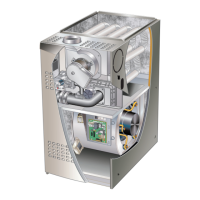
